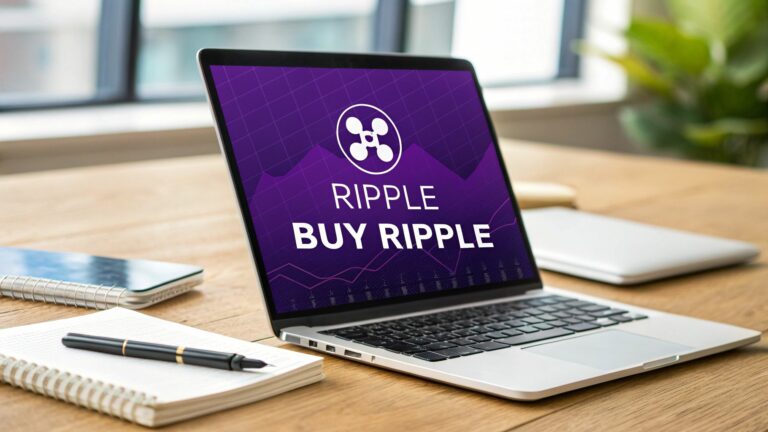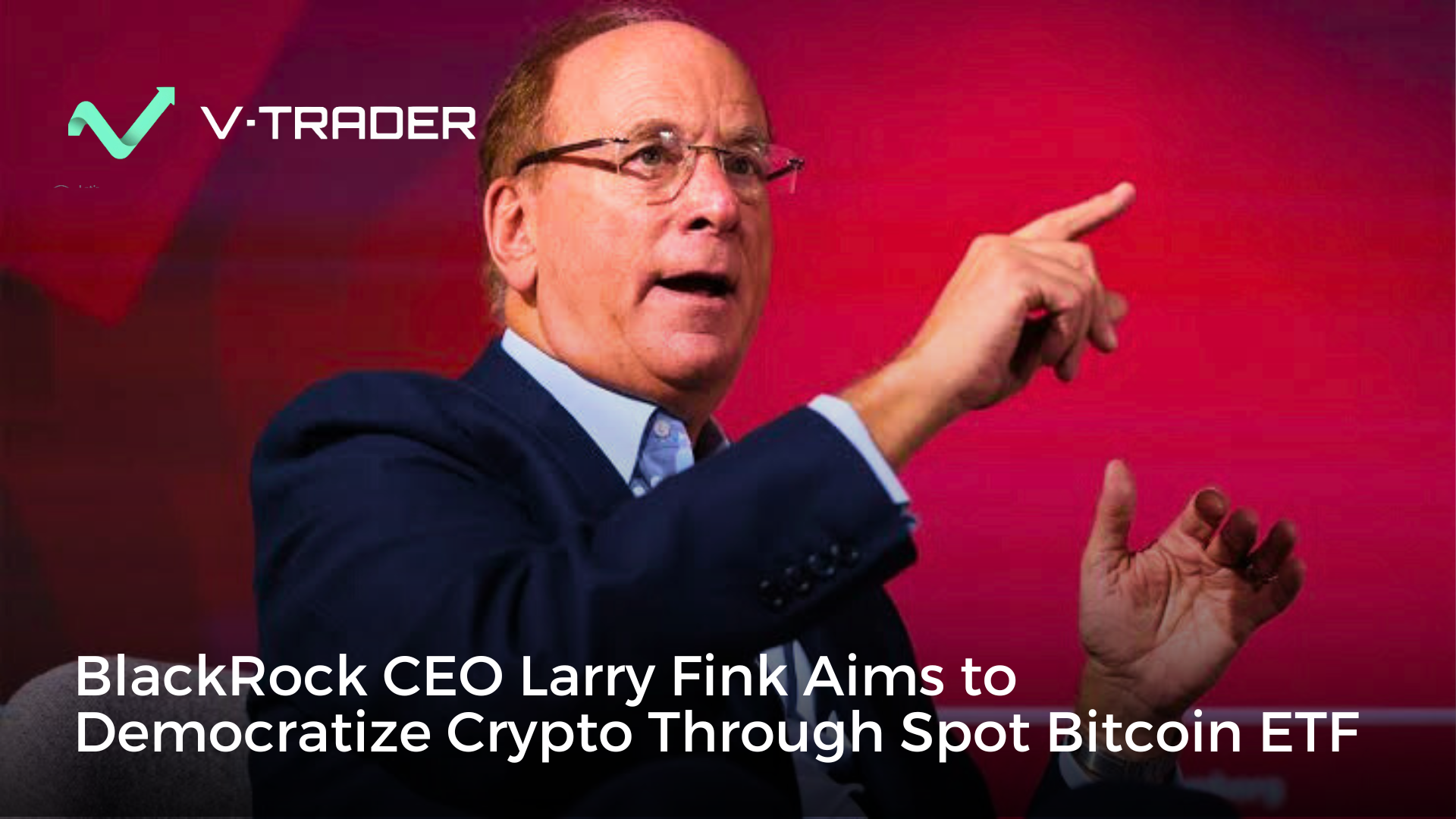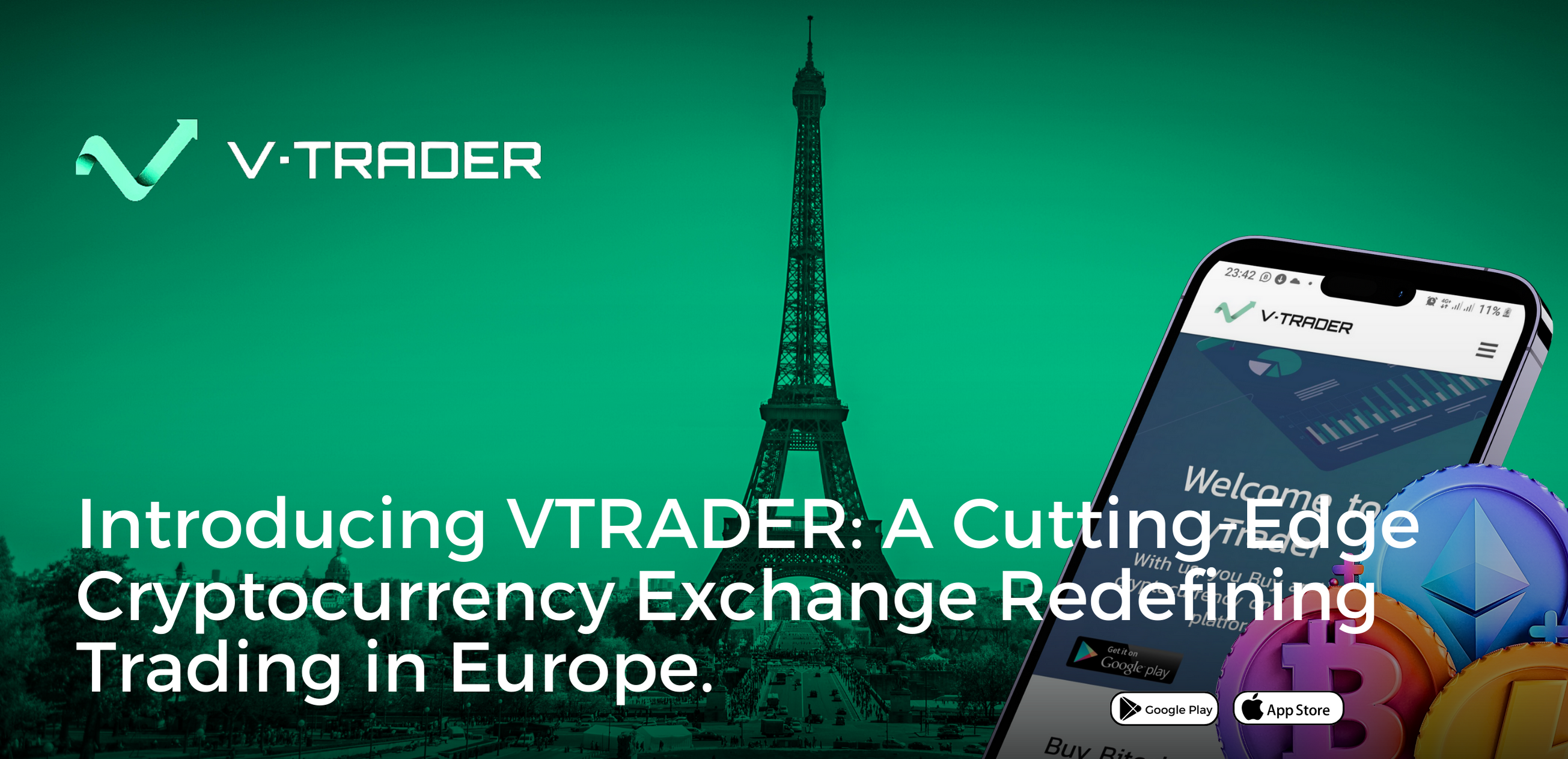The best way to buy Ripple (XRP) is through a secure, user-friendly crypto exchange that gets the balance right between low fees and solid security. For most people, a well-regulated centralized exchange like vTrader offers the ideal blend of simplicity and powerful trading tools. This route just makes the whole process easier, from funding your account to placing your first trade.
Choosing the Right Platform to Buy Ripple
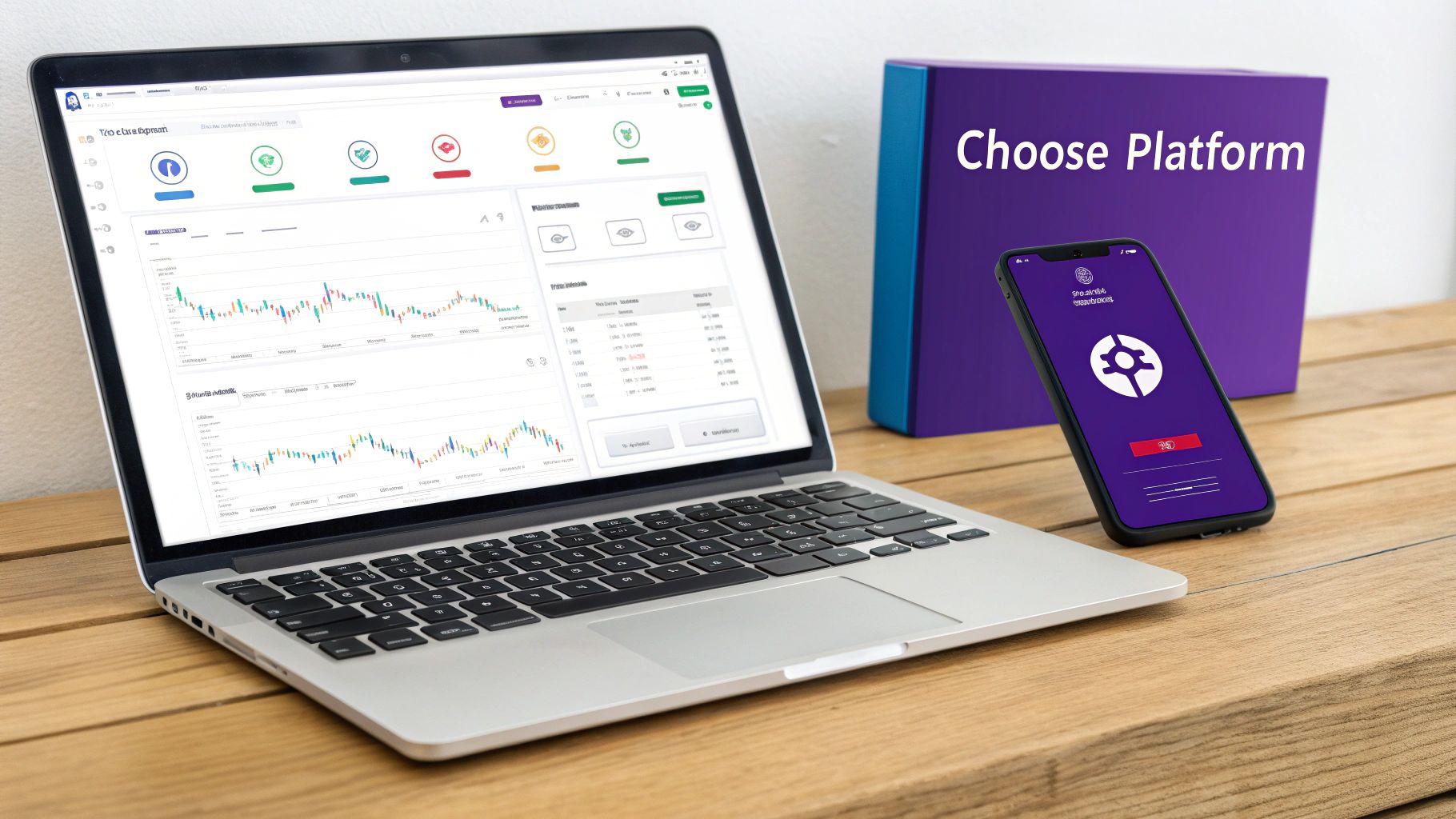
Finding the perfect place to buy XRP can feel like a maze, but it really just comes down to knowing the three main types of platforms: centralized exchanges, decentralized exchanges (DEXs), and crypto brokers. Each one serves a different kind of investor.
Centralized exchanges, like vTrader, are the go-to for almost everyone, from total beginners to seasoned pros. They work like a trusted middleman, matching buyers and sellers in a regulated space. This setup feels a lot like online banking, complete with customer support and easy payment options like bank transfers and credit cards.
Weighing Your Options
On the flip side, you have decentralized exchanges (DEXs), which run without any central company in charge. They connect users directly using smart contracts, which means you have total control over your funds. While this is a huge plus for crypto purists who value self-custody, DEXs can be tricky to navigate and aren't always the most intuitive for newcomers.
Then there are crypto brokers. They offer the absolute simplest experience, but you often pay for that convenience. They buy XRP for you, but usually with a slightly higher price or an extra fee baked in. It's a classic trade-off: simplicity for cost.
For the vast majority of investors, a centralized exchange just hits the sweet spot. The security, easy-to-use interface, and clear fee structures create a dependable environment for that first purchase—which is exactly what you want when you're starting out and trying to avoid costly mistakes.
Key Takeaway: If you're a beginner looking for a secure and straightforward way to buy Ripple, a centralized exchange like vTrader is almost certainly your best bet. More advanced users who prioritize holding their own keys might lean toward a DEX.
With so many options, it's easy to get lost in the details. The table below breaks down the key differences to help you decide which path is right for you.
Comparing Top Platforms for Buying XRP
| Platform Type | Typical Fees | Best For | Security Features |
|---|---|---|---|
| Centralized Exchange (CEX) | Low (0.1% – 1%) | Beginners & Active Traders | 2FA, cold storage, insurance funds, regulatory compliance |
| Decentralized Exchange (DEX) | Variable (Network/Gas Fees) | Advanced Users & DeFi Enthusiasts | Self-custody, smart contract audits |
| Crypto Broker | Higher (Often 1.5%+) | Absolute Beginners Seeking Simplicity | Custodial services, often regulated as money transmitters |
Ultimately, choosing a platform comes down to what you value most. A CEX like vTrader offers a balanced, secure, and user-friendly experience, making it a reliable starting point for most people entering the crypto space.
Factors That Truly Matter
When you're making a final decision, zone in on a few things that will directly affect your experience.
Security is non-negotiable. Look for platforms that require two-factor authentication (2FA), keep the majority of assets in cold storage (offline), and have a clean track record.
Next, look at the fees. High fees can slowly eat away at your returns. It's not just about trading fees; you also need to know what it costs to deposit and withdraw your money. For a clear example of what to look for, you can explore the various vTrader fee schedules to see how a transparent model works.
Finally, think about the user experience. The platform should make it dead simple to deposit funds with your preferred method, whether that's a bank transfer or a debit card. A clean, intuitive interface means you can buy, sell, and manage your XRP without getting lost or confused.
Creating and Securing Your Account
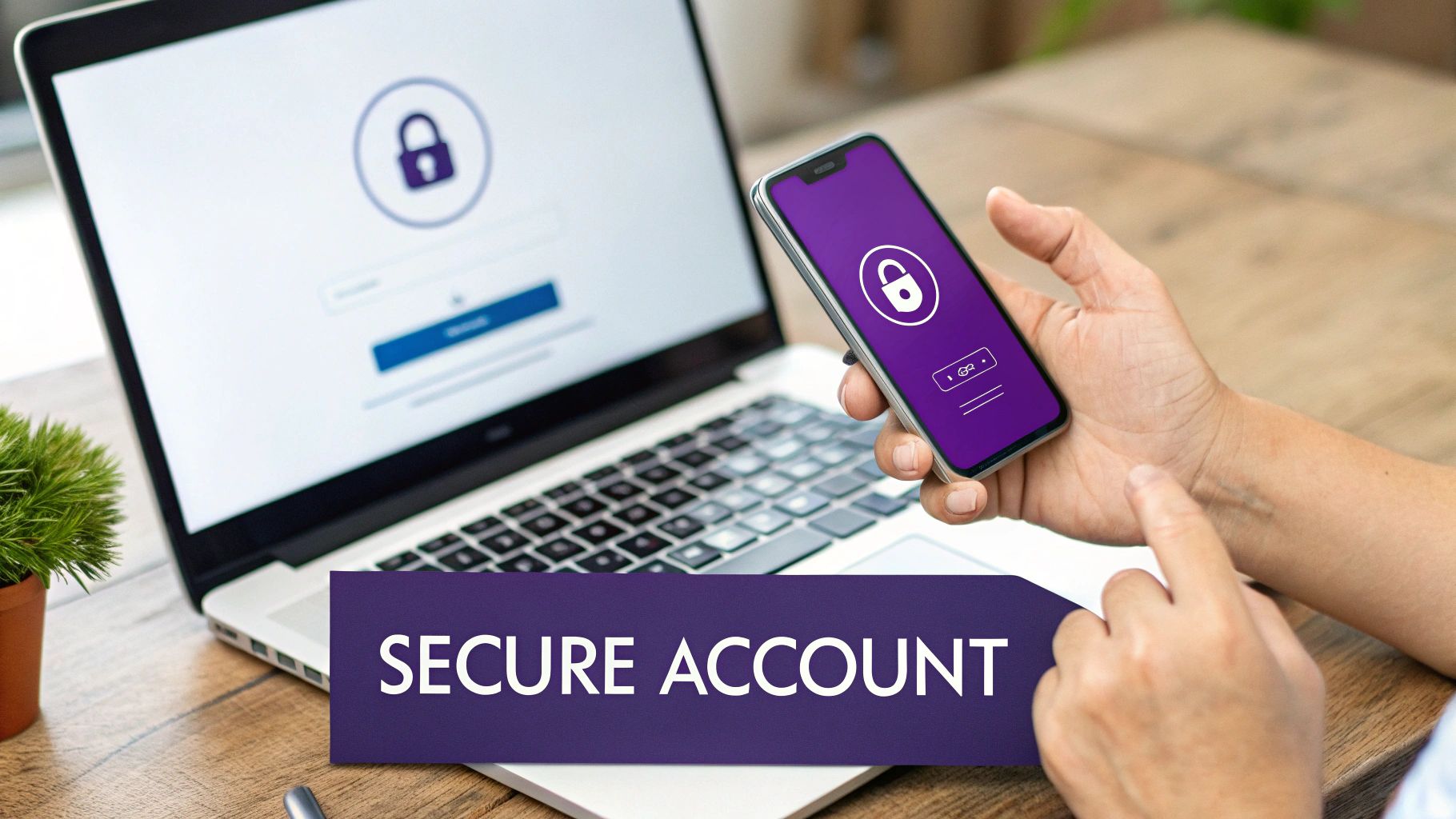
Alright, you've picked your platform. Now it's time to build your home base for trading. Think of this as laying the foundation for a house—get it right from the start, and everything you build on top of it stays secure. On an exchange like vTrader, the process is straightforward but intentionally thorough.
You’ll start with the usual suspects: an email address and a strong password. My advice? Get a password manager. It creates and saves passwords that are nearly impossible for anyone to guess, which is a lot safer than trying to invent one yourself. After that, you'll click a link in your inbox to verify your email, proving you own it.
Verifying Your Identity
Next up is the Know Your Customer (KYC) process. This is non-negotiable for any regulated exchange. You’ll need to submit a government-issued ID and probably snap a quick selfie. It might feel like a hassle, but this is what keeps the platform safe from fraud and bad actors.
This verification step is a huge part of what makes a trusted exchange the best way to buy Ripple. It filters out the sketchy stuff and helps create a secure environment for everyone. The whole thing is usually automated and only takes a few minutes.
Pro Tip: Have your ID ready before you even start. I’ve found it’s way easier to do the KYC part on my phone. The camera is right there, and you can get a clear shot of your documents. Just make sure you’re in a well-lit room with no glare to get approved on the first go.
Once your identity is confirmed, your account is technically live. But don't you dare deposit a single dollar yet. The most important security step is still ahead, and skipping it is a rookie mistake I see far too often.
Activating Two-Factor Authentication
Before you even think about funding your account, enable Two-Factor Authentication (2FA). This is your digital bodyguard, adding a layer of security that a password alone can't provide. And please, don't use SMS for your codes. It's vulnerable to SIM-swapping attacks. An authenticator app is the way to go.
Here’s how to get it done:
- Get an Authenticator App: Download a trusted one like Google Authenticator or Authy.
- Scan the QR Code: Head to your vTrader security settings and choose to enable 2FA. Your app will scan the QR code that pops up on the screen.
- Save Your Backup Key: The exchange will give you a recovery code. Write this down on a piece of paper and store it somewhere safe—and offline. Do not screenshot it or save it in a digital note. If you lose your phone, this is your only way back in.
- Confirm It: Type the six-digit code from your authenticator app into the exchange to finish the setup.
From now on, logging in or making a withdrawal will require both your password and a fresh code from your phone. This one simple habit can block over 99% of automated cyberattacks, making it absolutely essential for protecting the XRP you're about to buy.
If you want to dive deeper into these security topics, the vTrader Academy offers excellent guides on keeping your crypto safe.
Funding Your Account Smartly
Now that your vTrader account is set up and secured, it’s time to decide how to move funds in. Your choice boils down to a trade-off between speed and cost. On vTrader, you’ll mainly choose between bank transfers and credit/debit cards—each suited to different situations.
Think of a credit card as the fast lane: funds land almost instantly. A bank transfer feels more like a leisurely drive—slower, but kinder to your wallet.
Speed Versus Cost Dilemma
Credit and debit cards deliver funds within minutes, which is gold if XRP suddenly dips and you want to pounce. Just be mindful of processing fees between 2% to 5%, and the possibility that your issuer treats crypto buys as cash advances.
Bank transfers (ACH in the US, SEPA in Europe) take one to three business days, but they typically incur near-zero fees. You’ll save more in the long run—just be prepared to wait for your ideal entry point.
| Method | Time To Clear | Fees |
|---|---|---|
| Credit/Debit Card | Minutes | 2% to 5% |
| Bank Transfer (ACH or SEPA) | One To Three Business Days | Near zero |
I once watched a friend hold off on a bank transfer for three days—he saved on fees but missed a 15% rally in XRP. Sometimes, timing beats thrift.
Choosing Your Funding Strategy
Which method wins? It depends on what you’re chasing:
• Urgent Market Entry: Use a card to snag XRP during sudden price swings.
• Cost-Sensitive Investment: Send a bank transfer for larger amounts and keep fees minimal.
A hybrid approach works wonders: place a small test order with your card to lock in a position, then follow up with a bulk purchase via bank transfer. You’ll strike the balance between quick access and long-term savings.
When To Buy: Analyzing Market Signals
Knowing exactly when to buy XRP isn’t about predicting the next big wave. It’s more like tuning into a rhythm—spotting small clues before they turn into larger moves. Jumping in on impulse almost always backfires, so carving out logical entry points becomes your hedge against regret.
A quick glance at the price chart tells you more than a dozen headlines. You don’t need a PhD in technical analysis—just an eye for patterns. On vTrader, zoom in on recent candlesticks and watch for:
- Higher Highs and Higher Lows: A classic sign that buyers are in control.
- Lower Highs and Lower Lows: That often points to a cooling-off period.
- Volume Spikes: Sudden surges in trading activity can confirm a breakout.
By following these visual cues, you start to feel the market’s pulse rather than chasing after it.
Reading The Broader Market Context
Beyond price action, market capitalization is your compass. Think of it as the total dollar amount of all XRP in circulation. A heftier cap usually means healthier liquidity and less slippage when you buy or sell.
Consider this: XRP trading at $0.50 feels affordable—until you factor in a $30 billion cap. That tells you there’s serious money behind the asset. Fast-forward to later in 2024, and that figure jumped to about $120 billion. U.S. elections, favorable court rulings, and shifting regulations all played their part. These events can abruptly sway investor confidence and trading volume. Explore more on historical market caps via Statista.
Keeping An Eye On News And Sentiment
In crypto, news travels at light speed. A single tweet or announcement can nudge prices up or down in minutes. I’ve found that staying ahead of headlines separates cautious buyers from frantic ones.
Here’s my quick checklist before pulling the trigger:
- Regulatory Updates: Watch for SEC rulings or policy shifts.
- Partnership Announcements: Big-name bank collaborations often spark fresh interest.
- Market-Wide Moves: A Bitcoin surge usually lifts altcoins, XRP included.
- Social Media Buzz: High engagement on Twitter or Telegram can signal rising demand.
“I always carve out ten minutes before any buy—scrolling through trusted news feeds and community channels. That small window has saved me from jumping into false breakouts time and again.”
By weaving together price charts, market cap insights, and real-time sentiment, you build a strategy that’s rooted in logic rather than guesswork. Spot the patterns, check the bigger picture, scan the news—and then decide.
Placing Your First XRP Order
Alright, you've got funds in your vTrader account and you're ready to pull the trigger on your first Ripple purchase. This is the moment where all your research meets the market.
The most important decision you'll make here is how you buy. You have two primary tools at your disposal: market orders and limit orders. They might sound similar, but they serve completely different purposes, and picking the right one is key to making your strategy work.
A market order is the simplest and fastest way to get your hands on some XRP. Think of it as telling the exchange, "Buy me XRP right now at whatever the best price is." It’s perfect when you see a price you like and your main goal is to get into the market immediately before it moves.
The trade-off for that speed? In a volatile market, the price you actually get could be a fraction different from the one you saw on screen. This is known as slippage. It’s usually a tiny amount for a major coin like XRP, but it’s still something to keep in mind when things are moving fast.
Taking Control with Limit Orders
If you're less concerned with speed and more focused on price, the limit order is your best friend. Instead of buying at the current market rate, a limit order lets you name your price. You set the maximum you're willing to pay, and the order will only go through if the market price hits your target or drops below it.
Let's say XRP is trading at $0.55, but your analysis suggests it might dip to $0.52. You can set a limit buy order right at $0.52. Now, you can walk away from your screen. If the price drops, your order executes automatically. If it doesn't, you don't buy—and you don’t overpay.
I often use limit orders to automate my entry strategy. I'll identify a key support level on the chart and set my buy order there. It takes the emotion out of the trade and ensures I stick to my plan, whether I'm at my desk or not.
Before you make a move, ask yourself what matters more: getting in right now, or getting in at the right price? The infographic below shows the simple flow of checking key signals—market cap, news, and charts—before you decide.
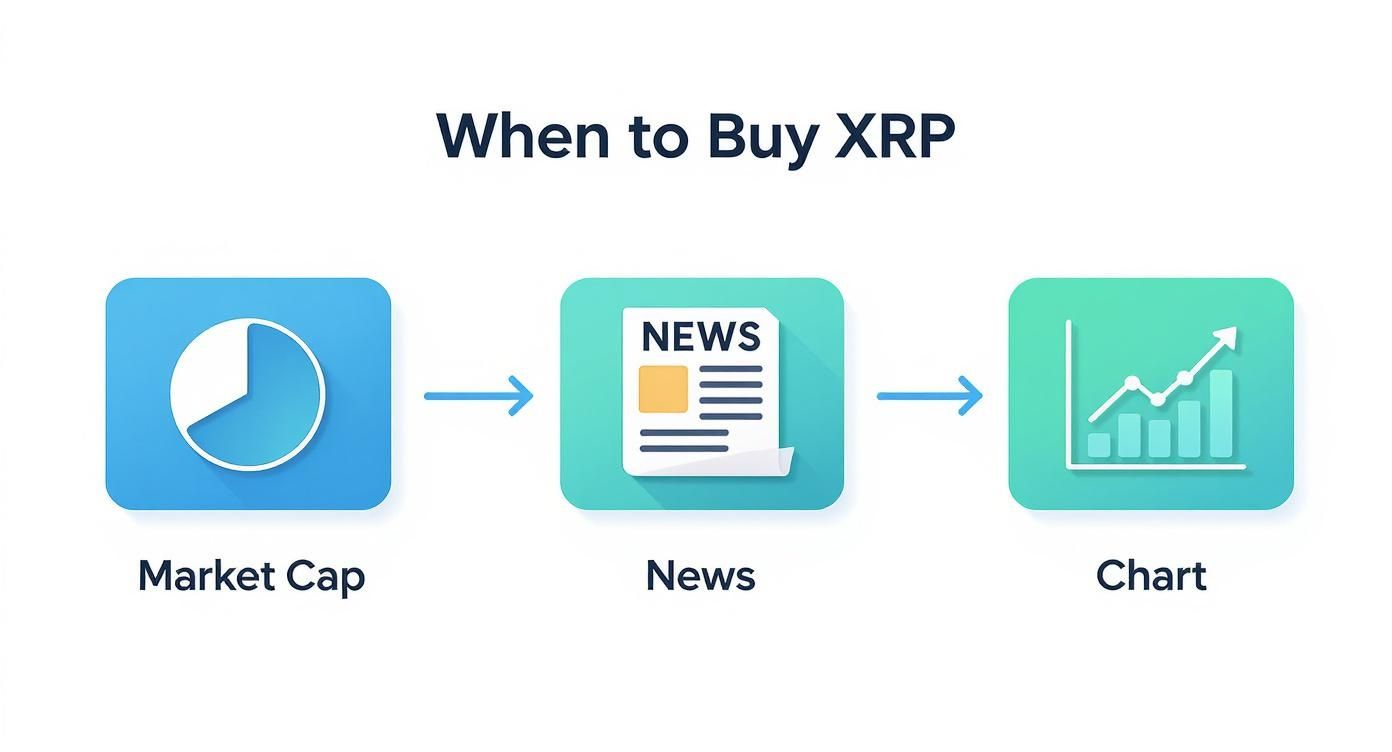
This just reinforces the idea that your order type should be a direct reflection of what the market is telling you.
Executing the Trade on vTrader
When you’re ready, head over to the vTrader trading screen. You can find all the live data and charts on the XRP currency pair on vTrader to help finalize your decision.
From there, it's straightforward:
- Select your order type (Market or Limit).
- Enter the amount you want to spend (in USD) or the amount of XRP you want to buy.
- Carefully review all the details.
Always double-check the total cost, including the small transaction fee, before you confirm. Hit "Buy XRP," and your order is live.
If it's a market order, the XRP will land in your wallet almost instantly. If it's a limit order, it will sit patiently until your price is met or until you decide to cancel it.
And that's it. Congratulations—you’ve officially made your first trade.
Moving Your Ripple to a Secure Wallet
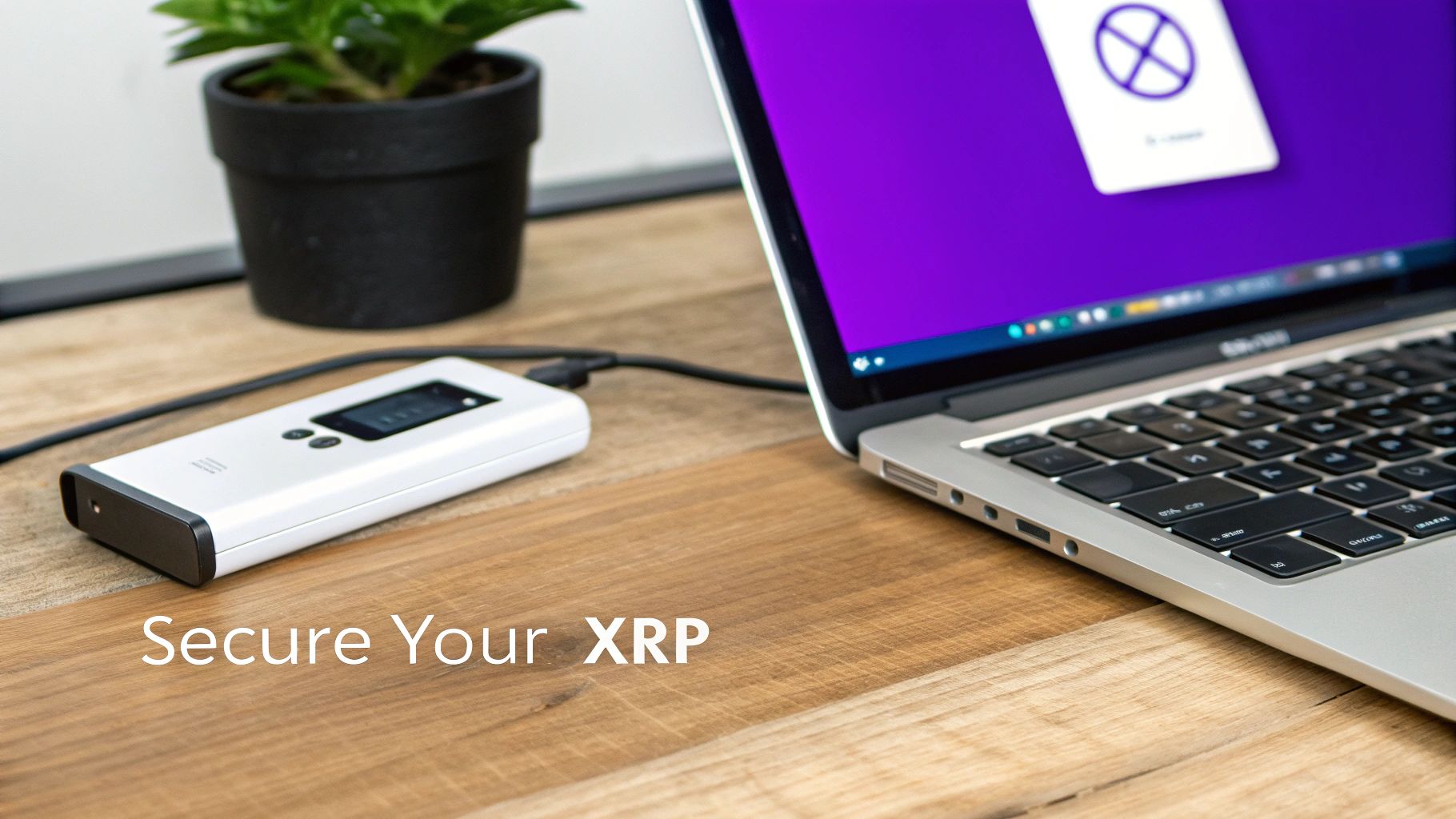
Alright, you’ve bought your XRP on vTrader. That’s a huge first step, but the job isn't quite done. Think of it this way: you wouldn't leave a stack of cash sitting on a store counter after you've bought something. Leaving your crypto on an exchange is pretty much the same thing.
It's convenient, sure, but it exposes your assets to risks completely outside your control. You’ve probably heard the phrase "not your keys, not your coins," and it’s one of the most important rules in crypto. When your XRP is on an exchange, you don't actually hold the keys. The exchange does.
To take true ownership and secure your investment for the long term, moving your XRP into a personal wallet is non-negotiable.
Hot Wallets vs. Cold Wallets
You've got two main options here: a software wallet (hot) or a hardware wallet (cold). They both do the same basic job, but they're built for different needs.
- Software (Hot) Wallets: These are just apps on your phone or computer. Because they're always connected to the internet, they’re perfect for making quick, frequent transactions. They're great for convenience but are naturally more exposed to online threats.
- Hardware (Cold) Wallets: These are physical devices, kind of like a specialized USB drive, that keep your private keys totally offline. This "cold storage" method is like having your own personal Fort Knox, making it the go-to for securing larger amounts you plan to hold for a while.
Key Insight: My personal strategy is a hybrid one. I keep a small, "spending" amount of crypto in a trusted software wallet for easy access. But the vast majority—my serious, long-term holdings—is locked away safely in a hardware wallet. It gives me the best of both worlds: flexibility and genuine peace of mind.
Safely Transferring Your XRP
Once you’ve picked a wallet you trust and have gone through the setup—which always means writing down your recovery phrase and storing it somewhere safe offline—you’re ready to move your funds.
The process on vTrader is simple. Just head over to the withdrawal section for XRP.
You'll need your new wallet's public address. For XRP specifically, you might also need a Destination Tag, so double-check if your wallet requires one. I can't stress this enough: always send a small test amount first. Wait for that tiny transaction to show up safely in your personal wallet before you even think about sending the rest.
Once you’ve confirmed the test transfer worked, go ahead and send the full amount.
This final step is what solidifies your ownership. Now that you know more about how to store Ripple securely, you can feel confident exploring other opportunities on vTrader, knowing your main investment is properly protected.
Common Questions About Buying Ripple
It's totally normal to have a few last-minute questions before you pull the trigger on your first Ripple purchase. Let's run through some of the most common ones so you can feel confident hitting that "buy" button.
First up, a lot of people ask about the minimum purchase amount. The good news is that you don't need a lot of cash to get started. Ripple doesn't set a minimum, so it’s up to the exchange. On platforms like vTrader, you can usually start with as little as $10 to $25.
Another big one is about using credit or debit cards. The short answer is yes, you absolutely can. It's often the fastest way to buy XRP, but keep in mind that convenience comes at a cost—card processors usually charge higher fees than a standard bank transfer.
Is Leaving XRP on an Exchange Safe
This is probably the most important question of all. While reputable exchanges have strong security in place, there’s a saying in the crypto world you should never forget: "not your keys, not your coins."
When you leave your XRP on an exchange, you're trusting them to keep it safe for you. For long-term holding, especially if you build up a significant position, the gold standard is moving your crypto to a personal wallet where you control the private keys. For an even higher level of security, a hardware wallet is the way to go.
You can dig into more common queries and detailed answers in the vTrader FAQ section. It’s a great resource for clearing up any lingering questions.
Think of it like this: an exchange is for trading, and a personal wallet is for storing. Getting into the habit of using each for its intended purpose is one of the smartest things you can do to protect your crypto over the long term.
If you're curious about the tech that makes self-custody possible, it's worth learning a bit more about the fundamentals. This guide on What is Blockchain Development? is a great place to start. Understanding the "why" behind this stuff really helps it all click.
Ready to make your first trade with confidence? Join vTrader today and enjoy zero-fee trading on XRP and over 30 other cryptocurrencies. Get started now and claim your $10 sign-up bonus!

Steve Gregory is a lawyer in the United States who specializes in licensing for cryptocurrency companies and products. Steve began his career as an attorney in 2015 but made the switch to working in cryptocurrency full time shortly after joining the original team at Gemini Trust Company, an early cryptocurrency exchange based in New York City. Steve then joined CEX.io and was able to launch their regulated US-based cryptocurrency. Steve then went on to become the CEO at currency.com when he ran for four years and was able to lead currency.com to being fully acquired in 2025.
